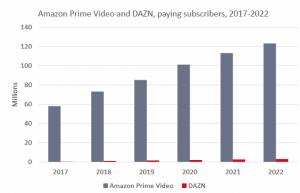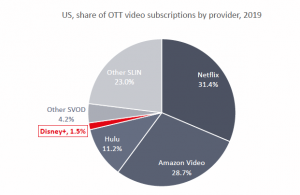
After more than 40 years of operation, DTVE is closing its doors and our website will no longer be updated daily. Thank you for all of your support.
Ovum: 10 predictions for 2019
 This year is likely to see an accelerating pace of change in the digital video business, driven by the launch of new direct-to-consumer offerings by content companies in competition with the likes of Amazon, migration of viewers to OTT TV offerings and changes in the way they find and consume content. As 2019 gets underway, Ovum’s analysts have set out their top 10 predictions for the year.
This year is likely to see an accelerating pace of change in the digital video business, driven by the launch of new direct-to-consumer offerings by content companies in competition with the likes of Amazon, migration of viewers to OTT TV offerings and changes in the way they find and consume content. As 2019 gets underway, Ovum’s analysts have set out their top 10 predictions for the year.
1. Gigabit broadband adoption will accelerate in 2019, with China leading the pack
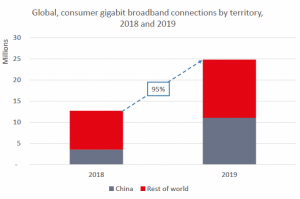
 2019 will be the year that consumer gigabit broadband services really start to accelerate, growing by 95% over the year to reach 24.8m subscriptions. This growth will be largely driven by China, which will equal 45% of consumer gigabit lines in 2019. By 2023, the gigabit market will have reached 108 million subscriptions –10% of all consumer broadband connections. However, although other countries are also starting to ramp up, China will continue to dominate with 49% of the global market.
2019 will be the year that consumer gigabit broadband services really start to accelerate, growing by 95% over the year to reach 24.8m subscriptions. This growth will be largely driven by China, which will equal 45% of consumer gigabit lines in 2019. By 2023, the gigabit market will have reached 108 million subscriptions –10% of all consumer broadband connections. However, although other countries are also starting to ramp up, China will continue to dominate with 49% of the global market.
Michael Philpott, senior practice leader consumer & entertainment services
2. Own-brand OTT video will become more than a side-show for pay TV leaders
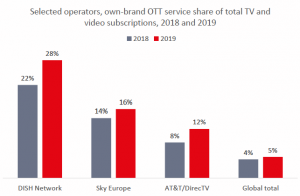
 Globally, 5% of standalone OTT video subscriptions will be provided by network operators by 2019. For many major pay TV operators -particularly those in mature or slow markets -that percentage will be well into double digits. The inevitable erosion in average revenue per user (ARPU) from more customers taking lower-priced services will be alleviated first by lower subscriber acquisition costs, and later strategies to increase prices and upsell customers to more premium offers.
Globally, 5% of standalone OTT video subscriptions will be provided by network operators by 2019. For many major pay TV operators -particularly those in mature or slow markets -that percentage will be well into double digits. The inevitable erosion in average revenue per user (ARPU) from more customers taking lower-priced services will be alleviated first by lower subscriber acquisition costs, and later strategies to increase prices and upsell customers to more premium offers.
Jonathan Doran, principal analyst, media and entertainment
3. OTT will take nine in 10 new advertising dollars spend on TV and video
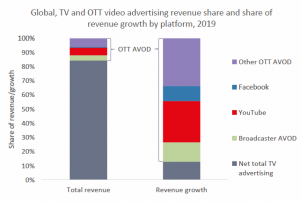
 Ad-funded video on-demand (AVOD) revenue growth will eclipse that of global traditional TV advertising in 2019. Broadcasters will take just 16% of 2019’s new OTT AVOD dollars as they struggle against the scale, targeting options, innovative ad formats, and growing quality of contention Google’s YouTube -and other newer OTT-first platforms. Broadcasters must rethink their approaches to content production, ad strategy, and –most importantly -their competitors.
Ad-funded video on-demand (AVOD) revenue growth will eclipse that of global traditional TV advertising in 2019. Broadcasters will take just 16% of 2019’s new OTT AVOD dollars as they struggle against the scale, targeting options, innovative ad formats, and growing quality of contention Google’s YouTube -and other newer OTT-first platforms. Broadcasters must rethink their approaches to content production, ad strategy, and –most importantly -their competitors.
Matthew Bailey, senior analyst, media and entertainment
4. Amazon will acquire DAZN to create a global sports TV challenger
 Sport is the missing piece of the content puzzle for the tech giants -but not for much longer if Amazon continues to bid for distributors with existing rights deals, such as Fox’s regional sports networks in the US. By acquiring DAZN, Amazon would gain strong sports rights in key global markets including Germany and Japan. DAZN is committed to the sports market but might find the support and growth acceleration offered by Amazon –and its huge existing subscriber base – too alluring to resist.
Sport is the missing piece of the content puzzle for the tech giants -but not for much longer if Amazon continues to bid for distributors with existing rights deals, such as Fox’s regional sports networks in the US. By acquiring DAZN, Amazon would gain strong sports rights in key global markets including Germany and Japan. DAZN is committed to the sports market but might find the support and growth acceleration offered by Amazon –and its huge existing subscriber base – too alluring to resist.
Ed Barton, chief analyst, media and entertainment
5. Disney+ will secure less than 2% share of the US OTT video market
 Disney’s family-centric OTT app Disney+ is set to launch in 2H19. The service will host all its cherished movies and TV shows. At a lower monthly cost than Netflix, at around US$5 per month, Disney+ is likely to become a household name in the US with time. But it will take years to become a major player in the oversaturated US streaming market. In 2019, Disney+’s market share will be less than 2% – and for that to happen, Disney must acquire three million subscribers in just six months, a formidable challenge.
Disney’s family-centric OTT app Disney+ is set to launch in 2H19. The service will host all its cherished movies and TV shows. At a lower monthly cost than Netflix, at around US$5 per month, Disney+ is likely to become a household name in the US with time. But it will take years to become a major player in the oversaturated US streaming market. In 2019, Disney+’s market share will be less than 2% – and for that to happen, Disney must acquire three million subscribers in just six months, a formidable challenge.
Tony Gunnarsson principal analyst, media and entertainment
6. Sky will offer Hulu in Europe to highlight its new aggregator role
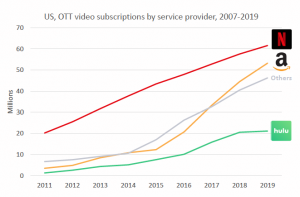
 With its domestic market maturing, Hulu is ripe for international expansion. Sky, meanwhile, will struggle to find revenue growth from its European pay TV business. During 2019 we expect it to add Hulu to its bundles, following its recent move to offer access Netflix via its platform. By providing an easily navigable single destination, Sky will attract new customers into its universe including, crucially, a younger, OTT-centric generation, to upsell a variety of services to in the coming years.
With its domestic market maturing, Hulu is ripe for international expansion. Sky, meanwhile, will struggle to find revenue growth from its European pay TV business. During 2019 we expect it to add Hulu to its bundles, following its recent move to offer access Netflix via its platform. By providing an easily navigable single destination, Sky will attract new customers into its universe including, crucially, a younger, OTT-centric generation, to upsell a variety of services to in the coming years.
Adam Thomas, lead analyst, global TV markets
7. eSports revenue will breach the US$1 billion barrier in 2019
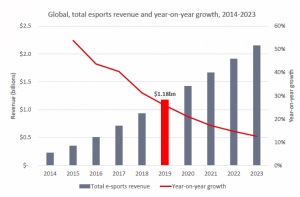
 Total eSports revenue will surpass the symbolic US$1 billion level next year, buoyed by the ever-increasing clamour for sponsorship and media rights. In particular, telcos will flood the market in 2019 as they increasingly see eSports as the perfect fit for demonstrating their 5G credentials and targeting the next generation of smartphone users. Meanwhile, mobile eSports titles themselves will make major headway in the West to become another lucrative aspect of the discipline.
Total eSports revenue will surpass the symbolic US$1 billion level next year, buoyed by the ever-increasing clamour for sponsorship and media rights. In particular, telcos will flood the market in 2019 as they increasingly see eSports as the perfect fit for demonstrating their 5G credentials and targeting the next generation of smartphone users. Meanwhile, mobile eSports titles themselves will make major headway in the West to become another lucrative aspect of the discipline.
Dom Tait, principal consultant, consumer & entertainment services
8. Android TV will dominate new pay TV operator set-top box deployments
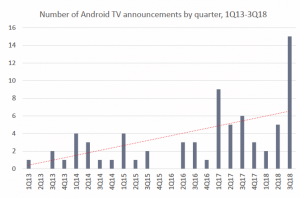
 Growing momentum behind Android TV will accelerate in 2019. TV STB vendors are positioning custom Android TV launchers as one of their prime products to operators. Android TV dominated middleware-related announcements in 2018 over 25 in the first nine months. The Google-owned platform increasingly speaks to the needs of mid-and low-tier operators, due to the promise of flexibility, quick time-to-market, lower opex, and reliable support from Android’s large developer community.
Growing momentum behind Android TV will accelerate in 2019. TV STB vendors are positioning custom Android TV launchers as one of their prime products to operators. Android TV dominated middleware-related announcements in 2018 over 25 in the first nine months. The Google-owned platform increasingly speaks to the needs of mid-and low-tier operators, due to the promise of flexibility, quick time-to-market, lower opex, and reliable support from Android’s large developer community.
Ismail Patel, senior analyst, media and entertainment
9. Amazon will prioritise smart TV integration over media streamer growth in 2019
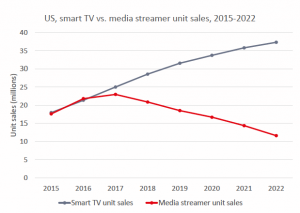
 As media streamer sales continue to decline, Amazon will focus on getting its Fire TV software in smart TVs in order to slowly chip away at the market share of Android TV (Google), Tizen OS (Samsung), WebOS(LG), and Roku. Late to the game, Amazon has partnered with Best Buy to exclusively showcase and sell Fire TV Edition smart TVs. If successful, Amazon will have a long-term consumer base to pitch Amazon Channels –the most fully-fledged pay TV platform replacement from the tech giants.
As media streamer sales continue to decline, Amazon will focus on getting its Fire TV software in smart TVs in order to slowly chip away at the market share of Android TV (Google), Tizen OS (Samsung), WebOS(LG), and Roku. Late to the game, Amazon has partnered with Best Buy to exclusively showcase and sell Fire TV Edition smart TVs. If successful, Amazon will have a long-term consumer base to pitch Amazon Channels –the most fully-fledged pay TV platform replacement from the tech giants.
Rishi Kaul, research analyst, consumer technology
10. Alexa will be the first AI assistant to detect users’ emotions and wellbeing
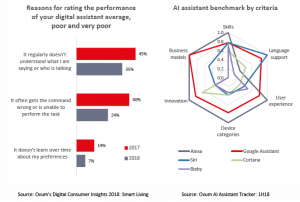
 AI assistants are getting better at understanding user commands and learning about their behaviour and preferences. Ovum predicts that in 2019 Amazon will take this to the next level by enabling Alexa to detect the health and emotional state of users, to offer them relevant advice while selling more products. This technological innovation has the potential to disrupt the AI assistant market as a whole, giving Amazon a greater competitive edge over rivals by making Alexa a more compelling and useful AI assistant.
AI assistants are getting better at understanding user commands and learning about their behaviour and preferences. Ovum predicts that in 2019 Amazon will take this to the next level by enabling Alexa to detect the health and emotional state of users, to offer them relevant advice while selling more products. This technological innovation has the potential to disrupt the AI assistant market as a whole, giving Amazon a greater competitive edge over rivals by making Alexa a more compelling and useful AI assistant.
Mariana Zamoszczyk, senior analyst, consumer & entertainment services
